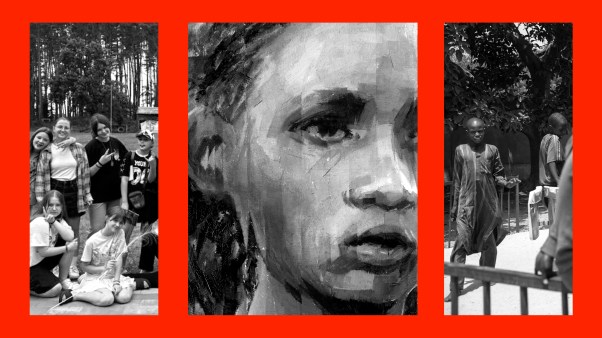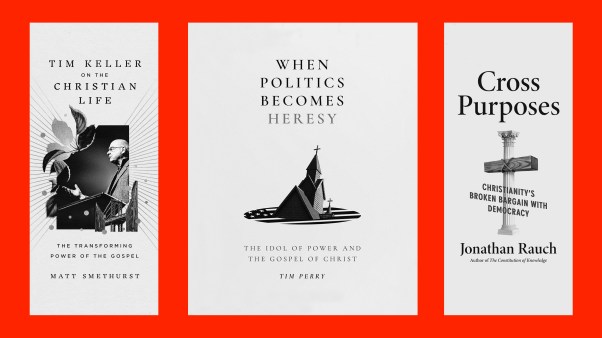Fantasy: A Reader’S Passport To Reality
Fantasy is a world better entered into than understood. It is as varied as cloud shapes on a summer day. As a literary genre, it covers everything from supernatural/horror stories to the low fantasy of sword and sorcery, and from animal fantasy, such as Walter Wangerin’s excellent The Book of the Dun Cow, to high fantasy like that of Tolkien or Lewis.
Good fantasy pulsates with power. It touches a reader’s beliefs, his way of viewing life, his hopes, his dreams, and his faith. In the hands of a careful writer it can drive home spiritual truth as nothing else can. In that light, it is encouraging to see newer writers tackling this form.
Charles Beamer in Lightning in the Bottle (Nelson) and John White in The Iron Sceptre (IVP) have done precisely that, just as Charles Williams did in All Hallows’ Eve (Eerdmans) a generation ago.
Beamer is a former English teacher and educational consultant. The first book in his fantasy series, The Legends of Eorthe, was Magician’s Bane. It was all that a first novel often is: a little too moralizing and a little too imitative. But Lightning in the Bottle strikes a very different and more pleasant note. It reveals a significant amount of artistic growth on Beamer’s part, with moral lessons less preached and more shown. And the story stands more on its own than it does in the shadow of Narnia.
The principal characters are Jodi and Martin Westphall, Eric Vanover, Richard Brogan, and Jon, a mute. These youngsters go to Eorthe, a dimensional twin to Earth, to participate in a conflict between those who seek the King, who is the Lord of Light and the book’s Christ figure, and the forces of darkness, personified in Jabez and Sarx, sorcerer sons of Ingloamin, Lord of Darkness. Although this sounds a bit dualistic, Beamer steers clear of that by making the King the son of Abba, Father of Light and Creator of Eorthe and Earth. Ingloamin is but a created thing of the void.
The children are sent to recover the stolen Lightning in the Bottle, a symbol for the Eorthians of faith in Abba and the King. Their quest is aided or hindered from all sorts of strange sources—a wind god named Win-dor, wolvors, bogloams, and fearsors. The Leohtians, or Light People, are the most original and memorable of the lot.
John white, who is an associate professor of psychiatry at the University of Manitoba, is the author of several nonfiction works. His first novel, The Tower of Geburah, unfortunately falls into a category of children’s books enjoyable only to children. The Iron Scepter, however, has less of that limitation as White, like Beamer, shows signs of growth as a novelist—although to a lesser degree. He retains at least two irritating little quirks: he inserts himself into the narrative (just because Lewis did it in Narnia doesn’t make it a good thing to do), and he has chosen inappropriate, or at least illsounding, names: “Anthropos,” a kingdom in White’s fantasy world, whose symbolism is painfully obvious; “Gaal,” pronounced according to the book’s index as “Gahl,” the Christ figure; and “Theophilus Gorgonzola Roquefort de Limburger V,” a flying horse. All of the names aggravate more than illuminate.
Apart from that, the story is agreeably interesting. The children are Kurt, Wesley, and Lisa Friesen, and their cousin, Mary McNabb. The conflict is between Kardia, King of Anthropos, and Mirmah, the Lady of Night and Empress-to-Be of the Darkness that Swallows the World. The resultant story is illuminated by spiritual insight and truth.
It is obvious that parallels to both Narnia and Middle Earth are abundant in both books: children who answer a call to go into another world to battle evil; the involvement of their battle in some kind of epic quest; at least one child who starts “bad” and ends “good”; a villain who stands in the place of a deeper, more evil force; evil that is overcome not by might nor power, but by belief in the book’s Christ figure; and so on.
This is not to say that these books are merely pale imitations of other works. Look, for instance, at the formulas used by detective fiction, romances, thrillers, and some “literary” novels. What counts is the author’s ability to put something unique and living within the formula.
To varying degrees, Beamer and White both have created that unique something within their novels. The books are readable and well worth their price of admission. If they are at times irksome, they are also at times awesome. Each has a good appendix to keep up with names, places, language oddities, and other items of interest. Quite frankly, I look forward to what both these men will produce when they hit their stride.
All Hallows’ Eve is totally different from the Beamer and White novels. For one thing, it is a reprint—long overdue—of a Charles Williams classic. Also, it is horror, not high, fantasy. Its secondary world is not a place of monsters, heroics, and Christ figures, but rather a dismal/glorious (depending on your view) place where one’s true nature reigns supreme. It is the City, a place close in nature to purgatory, and it lies spiritually superimposed on London just after World War II.
Two of the novel’s characters, Lester and Evelyn, are dead. In the City, the inner realities of their earthly lives work themselves out, pointing Lester to ever-higher realms and Evelyn to ever-lower. Entwined in this is Father Simon, a sorcerer, who intends to break the boundaries of the City by sending his illegitimate daughter, Betty, there permanently. The conflict that ensues with its climax on All Hallows’ Eve (Halloween) makes for a highly dramatic novel rife with spiritual imagery. Be sure to read T. S. Eliot’s introduction. It offers valuable insight into both the meaning of All Hallows’ Eve, and Williams as a person.
Reviewed by Larry E. Neagle, a free-lance writer in Fort Worth, Texas.
Like Ships In The Night
Toward a World Theology: Faith and the Comparative History of Religion, by Wilfred Cantwell Smith (Westminster, 1981, 206 pp., $18.95), is reviewed by Bruce Demarest, professor of theology, Denver Seminary, Denver, Colorado.
A Harvard authority on world religions, Wilfred Cantwell Smith, advances a relativistic model of the leading faiths: a Christian is one who participates in the complex of Islamic religious life—and so on. This means, first, that there is no one religion higher than any other, and second, that God is at work in Buddhist, Hindu, and Islamic religious history.
Postulating the model of “corporate critical self-consciousness,” Smith insists that religious knowledge involves that which can be personally experienced by all (the subjective pole) and that which can be scientifically analyzed (the objective pole). To avoid provincialism, it is necessary to participate in the consciousness of those of other faiths. For example, one should understand what the temple ritual means to pious Hindus and what fetishism and ancestor worship signify to African traditional religionists. Only then can a person begin to construct a theology that is truly global.
Faith, according to Smith, is a universal quality of human life. Faith is not assent to truths; rather, it is a way of viewing one’s neighbor and the world. Instead of Christian faith or Buddhist faith, one must speak of faith in a generic sense. Since God is at work in all religions, and since faith is a fundamental human quality, Smith concludes that a person is saved by participation in the life of one or another of the world’s religious communities. Thus, God saves Buddhists through the teachings of the Buddha and Hindus through the poetry of the Gita. Smith argues that this generic approach to religion enables modern man to be a compassionate pluralist without being a nihilist, and it offers a viable basis for building a peaceful world order.
The evangelical Christian will disagree with many of the author’s conclusions. Smith argues that as a rational animal, man is capable of securing all truth by application of the scientific method. One finds no acknowledgement of sin or the need for special revelation to impart truths beyond human apprehension. Indeed, Smith does not appeal to a single text of Scripture to support his case.
The Bible, furthermore, never links salvation with mere participation in a religious community. Paul regarded his early life in Judaism (Gal. 1:13–16), and the Thessalonian Christians saw their experience in traditional religion (1 Thess. 1:9–10), as conditions of darkness rather than fight.
Finally, the Christian understanding of God, man, sin, and salvation differs so radically from the Hindu and Buddhist views that the situation is not unlike ships passing in the night. We ought to avoid a narrow provincialism, but when conflicting claims are presented, we must make a choice. If one view offers a coherent explanation for the miraculous works and resurrection of Christ and others fail to do so, the inquirer has good reason to accept the supported view and reject contradictory alternatives.
In sum, Smith’s scholarly study is wanting at crucial points. It does, however, confirm the aphorism, “There is nothing like comparative religions to make a person comparatively religious.”
Using The World Christianly
Bent World: A Christian Response to the Environmental Crisis, by Ron Elsdon, (IVP, 1981, 170 pp., $4.95), is reviewed by Martin LaBar, professor of science, Central Wesleyan College, Central, South Carolina.
Ron Elsdon, according to the cover and contents of Bent World, is an Irish geologist, of some prominence in his profession. He has obviously done a lot of work in writing Bent World, which is thorough, scholarly, and well documented—without being unreadable.
I found the book to be really two books in one. On the one hand, the middle half says essentially nothing about Christianity, but documents present problems of the world. A chapter each is concentrated on metals, energy, cities, and food. These chapters contain a lot of statistics, but unfortunately, these will soon be out of date. Nonetheless, they do present the difficulties in a comprehensive manner.
On the other hand, there is a Christian response to the environmental crisis. The first chapter sketches the environmental views of a diverse group (a commission of the World Council of Churches, the National Evangelical Anglican Congress, Paul Ehrlich, J. R. W. Stott, Lynn White, Jr., and others). The last three chapters, on the effects of sin, the implications of salvation, and what Christians can and should be doing, are the best part of the book. It is difficult to imagine a more thorough use of the Bible in examining our relationship to the environment, and Elsdon has suggested things Christians can do. Especially, he wants us to be Christian in our attitudes toward material things and other people, and to question the status quo. We have not been a peculiar people.
Bent World is more thorough in relating Scripture to the issues than Earthkeeping (Loren Wilkinson, ed., Eerdmans), a book covering similar topics. It is also less expensive, though Earthkeeping is better written and more thorough in examining the historical roots of our attitude towards nature. Both deserve a place on the bookshelves and in the minds of Christians of our time.
Briefly Noted
Spiritual maturity has always been the goal of Christian nurture, even if it is not always attained. It is no different today, and several factors have heightened the push toward clarifying what that means. For instance, there is a new attitude among Christians toward psychology and what it has to offer; we have leisure to think about such things; material possessions have failed to give satisfaction; and the general insecurity of the times forces us inward. From the many (almost too many) books that attempt to show the way, the following selection presents those that have something to offer:
General. Something of an introductory theology of spirituality is The Heart of the World (Crossroad), by Thomas Keating. It is not too deep, but it does go in the right direction. More directive is Toward the Heart of God (Winston), by John Dalrymple, which describes the journey inwards and then out again. It is quite well done and shows the truth of Dag Hammarskjöld’s statement, “The longest journey is the journey inwards.” Transcend (Crossroad), by Morton Kelsey, is a full-blown guide to the spiritual quest that adds valuable insights from psychology (especially Jung). Although its 22 chapters are not woven totally together, it still provides much-needed help.
Three books deal with Christian meditation: Word into Silence (Paulist), by John Main, describes the Christian meditative experience, then offers a 12-step meditative program; Beyond TM (Paulist), by Marilyn M. Helleberg, is along the same line but more psychologically and practically oriented; Alone with God (Bethany Fellowship), by Campbell McAlpine, is a twopart manual covering pre-meditation and meditation from a wholly biblical perspective (Eastern parallels and psychological twists are absent).
Louis Dupré writes a searching, but all-too-brief introduction to mysticism in The Deeper Life (Crossroad). More detailed, but looking decidedly Eastward, is The Mirror Mind (Harper & Row), by William Johnson. This book looks directly at Zen meditation and Christian prayer, allowing them to flow constructively into each other. A collection of the late R. C. Zaehner’s essays is available as The City Within the Heart (Crossroad). The book provokes thought, as one would expect from Professor Zaehner. Paul Tournier’s The Whole Person in a Broken World (Harper & Row) is now available in paperback to help a new generation of seekers.
Navpress offers a nine-booklet set called Studies in Christian Living, covering the whole of Christian life from “Knowing Jesus Christ” (the first booklet) to “Achieving Victory” (the ninth). They are helpful, but sometimes have too little content. The ninth, for example, has 23 virtually blank pages (to be filled in by the reader) out of a total of 32. Although not specifically about spirituality, Gariy Friesen’s Decision Making and the Will of God (Multnomah) ought to be mentioned. It gives helpful guidance on how to discern God’s will and make decisions where there are no clear biblical guidelines. It is wise and careful in its suggestions.
Special Emphasis. Numerous attempts have been made to isolate the key element in spirituality. Sometimes it is overstated, sometimes it is not. The following group of 11 books offers a variety of answers to the question, “How do I become spiritually mature?”
In Living God’s Way (Kregel), F. E. Marsh says prayer is the secret of the spiritual life. There is much practical wisdom offered in support of this idea, but the either/or thrust upon the believer (either self or Christ) ignores the help psychology can give in redeeming rather than abandoning the self. The Promise of Paradox (Ave Maria), by Parker J. Palmer, celebrates the contradictions that are at the heart of human experience. To acknowledge these is to reach a new understanding of what it means to be spiritual, yet human. Bernard J. Tyrrell says healing comes through enlightenment in Christotherapy (Seabury). Using the insights of Frankl, Glasser, Dabrowski, and others, Tyrrell suggests that true spirituality comes from a loving response to the Christ-value, answering our most important prayer: “Lord, that I may understand.”
Dr. Messenger’s Guide to Better Health (Revell), by David L. Messenger, ties physical and spiritual health together in a sensible, down-to-earth way, stressing diet, exercise, and emotion. I might even start jogging myself! John W. Drakeford shows how to have stability when things begin falling apart in The Awesome Power of Healing Thought (Broadman). He uses Paul’s advice in Phil. 4:8 as a starting point: “Think on these things.” Richard J. Foster suggests that simplicity is the answer in Freedom of Simplicity (Harper & Row). This marvelous and helpful book shuns simplistic solutions in favor of simple ones that touch the bedrock of reality. Have You Felt Like Giving Up Lately? (Revell), by David Wilkerson, says it is by not giving up through the power of faith that you may heal your hurts. Donald Deffner sees the inner quest as a search for freedom in Bound to Be Free (Morse Press). Freedom is defined according to what it leaves behind, what it embraces, and what it requires.
Improving Your Serve (Word), by Charles R. Swindoll, develops the theme of selfless living as the essence of Christian servanthood. Tested by Temptation (Kregel), by W. Graham Scroggie, shows how to be fitted for Christian service by understanding properly what temptation is and how to overcome it. Richard J. Nouw suggests that action in our needy world is the key to spirituality in Called to Holy Worldliness (Fortress): we will then be agents of victory.
Personal Statements. Robert C. Girard has written a highly original and personal account of his own struggle toward spirituality in My Weakness: His Strength (Zondervan). It is easy to recognize bits of oneself in what Girard says and to be helped by his suggestions. The Promise of Hope (Abingdon), by William M. Kinnaird, is a collection of short, personal notes that tell of struggle, pain, and victory. Kinnaird’s honesty cannot help but benefit people in similar circumstances. A Cry for Mercy: Prayers from the Genesee (Doubleday), by Henri J. M. Nouwen, contains prayers written during Nouwen’s second stay at a Trappist monastery in upstate New York They are filled with freshness and insight—usual with Nouwen’s works. From another Trappist monastery, this one in Colorado, comes W. Paul Jones’s diary, The Province Beyond the River (Paulist). Its style is reminiscent of Nouwen’s earlier A Genesee Diary, and he, too, writes with insight and spiritual understanding.










